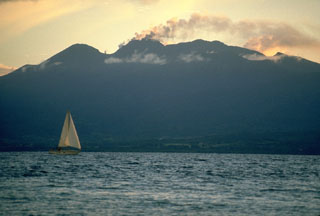Report on Soufriere Guadeloupe (France) — November 1976
Natural Science Event Bulletin, vol. 1, no. 14 (November 1976)
Managing Editor: David Squires.
Soufriere Guadeloupe (France) Phreatic explosions and mild steaming; evacuation ends 1 December
Please cite this report as:
Global Volcanism Program, 1976. Report on Soufriere Guadeloupe (France) (Squires, D., ed.). Natural Science Event Bulletin, 1:14. Smithsonian Institution. https://doi.org/10.5479/si.GVP.NSEB197611-360060
Soufriere Guadeloupe
France
16.044°N, 61.664°W; summit elev. 1467 m
All times are local (unless otherwise noted)
30 October: A 9-minute phreatic explosion occurred at about 1000. At 2238 a period of volcanic tremor began.
1 November: Phreatic explosion at about 1100.
6 November: Phreatic explosion at about 2200. The periods between phreatic explosions were characterized by mild steaming from fissures on the summit dome.
On 15-18 November, CNRS convened a committee of scientists in Paris to review the Soufrière situation and to assess the hazard posed by the volcano. This committee was chaired by Frank Press of the U.S., and included the following members: Shigeo Aramaki, Japan; Franco Barberi, Italy; Jean Coulomb, France; Richard S. Fiske, U.S.; Paolo Gasparini, Italy; Claude Guillemin, France; and Gudmundur Sigvaldason, Iceland.
The committee concluded that as of mid-November there was low probability of a dangerous eruption at La Soufrière, but that the situation could change. In order to detect these changes, the committee recommended an augmented program of study that included increased geological and petrological observation of the volcano and its ejecta, expansion of the deformation studies (precise levelling and tiltmetry), monitoring of volcanic gases, and expansion and improvement of seismic monitoring procedures. The committee report also outlined a possible model explaining the volcano's behavior. The model calls for the tectonic fracturing of hot rock or partly solidified magma beneath the volcano. This fracturing permitted the rapid influx of groundwater, of both meteoric and marine origin, which was then heated and driven off in copious outpourings of steam from the summit of the volcano. At times, steam was expelled with such violence that particles of pre-existing, altered rock were torn from the interior of the volcano and ejected to form airborne clouds of ash.
Several hours after the release of the committee report on 18 November, the French Government announced that the evacuation on Guadeloupe would end, and that the last of the 72,000 evacuees could return to their homes on 1 December.
Geological Summary. La Soufrière de la Guadeloupe volcano occupies the southern end of Basse-Terre, the western half of the island of Guadeloupe. Construction of the Grand Découverte volcano about 200,000 years ago was followed a Plinian eruption and caldera formation about 100,000 years later, and then by construction of the Carmichaël volcano within the caldera. Two episodes of edifice collapse and associated large debris avalanches formed the Carmichaël and Amic craters about 11,500 and 3,100 years ago, respectively. The present volcano subsequently grew within the Amic crater. The summit consists of a flat-topped lava dome, and several other domes occur on the southern flanks. Six phreatic explosive eruptions since 1690 opened radial fractures across the summit lava dome. The phreatic eruptions in 1976-77 caused severe economic disruption when Basse-Terre, the island's capital city immediately below the volcano, was evacuated.
Information Contacts: M. Feuillard, Lab. de Physique du Globe; J. Dorel, IPG, Paris; R. Fiske, SI.

